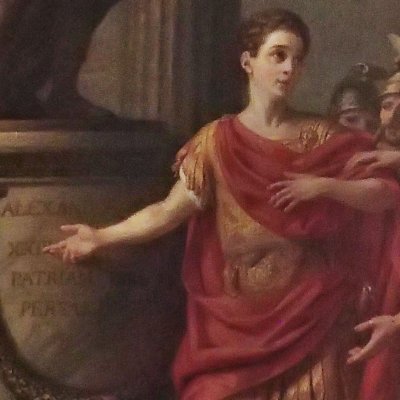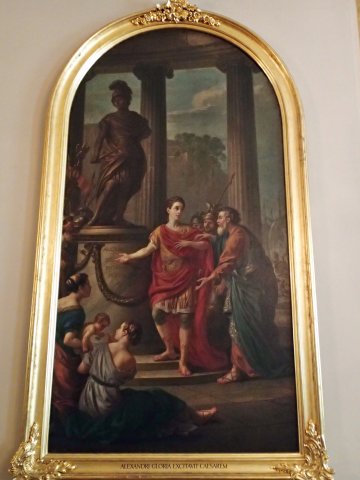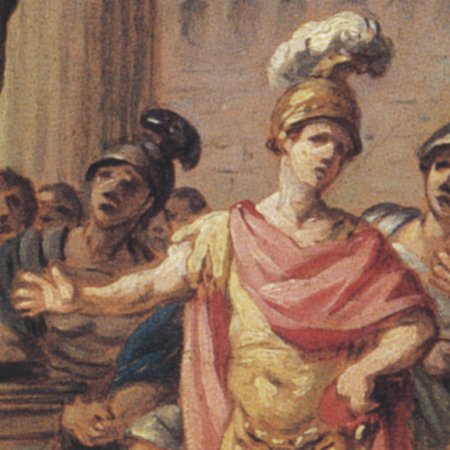Caesar facing the statue of Alexander - Vien
Notice précédente Notice n°4 sur 4
Description
Booklet from the 1767 Salon:
"By M. Vien, Professor. [...]
16. César débarquant à Cadix, trouve dans le Temple d'Hercule la Statue d'Alexandre, & gémit d'être inconnu à l'âge où ce Héros était déjà couvert de gloire.
Ce Tableau ceintré, de 8 pieds 9 pouces de haut, sur 4 pieds 9 pouces de large, appartient à S. M. le Roi de Pologne."
Mercure de France, October 1767, p. 164:
"We think the same about the painting representing Caesar who, passing in front of the statue of Alexander, groans to be unknown at the age when this hero was already covered with glory. This piece, commissioned by the King of Poland, a fair appraiser of virtues & stalens, unites to the pathos of the expressions, the brilliance of the coloring & the graces of a beautiful maneuver."
The episode takes place at the beginning of Caesar's career, when he has just been sent to Spain as quaestor (c. 60 BC), and before the first triumvirate and the conquest of Gaul: "As quaestor, it fell to him the later (= southern) Spain. [...] Having come to Gadès (= Cadiz), he noticed a statue of Alexander the Great near the temple of Hercules: he then began to groan and, as if disgusted by his inaction, thinking that he had not yet done anything memorable at an age when Alexander had already subdued the whole earth, he immediately asked for a leave of absence to seize as soon as possible, in Rome, opportunities to make his mark." (Suetonius, Life of Caesar, 7).
Vien may have been inspired by Roslin's Roman History.
1. The pedestal reads "ALEXANDER AN[NO] / XXIII NATUS / PATRIAM VERSUS / PERSAS CONSTI[TI]T"
.
The bottom of the frame reads "ALEXANDRI GLORIA EXCITAVIT CAESAREM".
2. Through Mme Geoffrin, the King of Poland, Stanislas Auguste Poniatowski, asked Boucher, Lagrenée, Vien and Hallé in 1765 to execute four canvases for the Chambre des Seigneurs at Warsaw Castle. The four canvases were to represent the "ideas of justice, emulation, magnanimity and concord" (Mme Geoffrin's letter to the King of Poland, January 29, 1766). La Continence de Scipion, designed by Boucher but finally executed by Vien in 1768, represented justice; César devant la statue d'Alexandre, the idea of emulation; La Tête de Pompée présentée à César, by Lagrenée, the idea of magnanimity; Scilurus et ses enfants, by Hallé, the idea of concord.
3. The sketch for this painting was acquired by the Musée d'Arras in 1968.
Technical Data
Notice #000760



